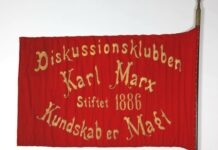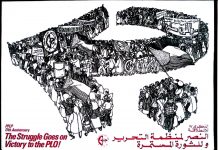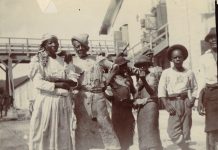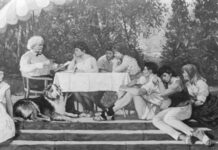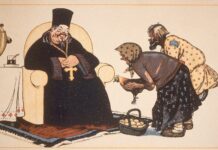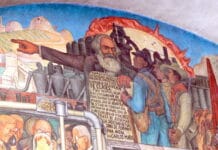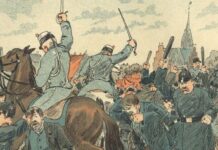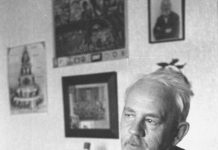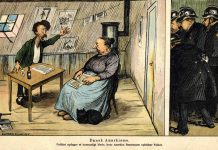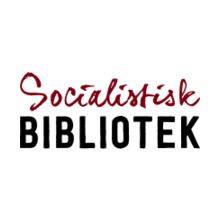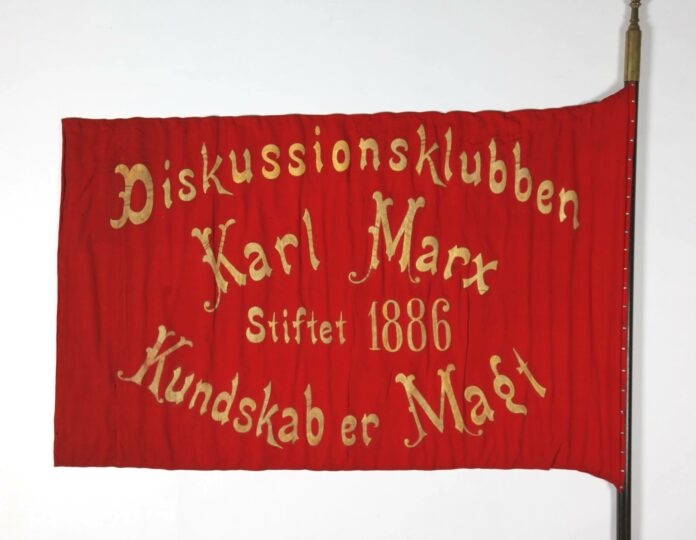
The International Working Men’s Association kontaktede den nystiftede Internationale Arbejderforening i København. Den danske forening var fra begyndelsen internationalistisk. Et resultat heraf var udgivelsen af marxistiske skrifter, f.eks. Kapitalen bind I og II. Desuden søgte foreningen at løse problemer, som opstod af modsætningen mellem en teoretisk samfundsopfattelse og praktisk politik båret frem af betydelige dele af arbejderklassen.
En upubliceret artikel fra 2018, skrevet af Gerd Callesen, tidligere forskningsbibliotekar på Arbejderbevægelsens Bibliotek & Arkiv (ABA), og oversat til engelsk af Lena Fluger. Han er nu pensioneret og bor i Wien, Østrig.
The International Working Men’s Association contacted the newly established International Workers’ Association in Copenhagen. From the outset, the Danish association had an internationalist outlook. One result of this stance was the publication of Marxist texts, e.g. Capital volume I and II. In addition, the association endeavoured to solve problems resulting from the discrepancy between a theoretical societal interpretation and practical policies, which would be supported by large groups of working people.
An unpublished article from 2018, written by Gerd Callesen, a former researcher at The Labour Movement Library and Archive, and translated into English by Lena Fluger. He is now pensioned and lives in Vienna, Austria.
Af samme forfatter: / By the same writer:
A brief history of the Danish labour movement
Indhold / Content
Early Interest
Civil War
The First Major Effort
Social Democrats and Left-Wing Opposition
Socialist Principles
Social Reforms
Mass Organization and Theoretical Basis
Newspaper Agitation
Health Insurance and Old-Age Relief
Internationalism
Publishing Marxist literature
The Price of Knowledge
Insight into Marx’ Role
The Publishing Project
A Long-Term Perspective
Another Try
Theory and Practice
Danish Efforts to promote International Action
What happened to Internationalism?
See also
In the spring of 1871 the earliest attempt was made to establish a revolutionary government in Paris. This popular rebellion was supported by the International Working Men‘s Association (IWMA), for instance, by publishing an analysis of this attempt in a pamphlet by Karl Marx ”The Civil War in France”.
The uprising was brutally suppressed by the forces of the French state, but in the course of that year, new sections of the IWMA were established, for example also in Denmark. The Danish section undertook to publish Marx’ analysis in its paper, and also printed the Statutes of the International in 1871. Thus, it positioned itself in a confrontational stance towards the existing social order in Denmark. This first social democratic organization proper saw the light of day in October 1871; it immediately joined the IWMA. Thus, the Danish labor movement was socialist from the outset.
Early Interest
Since the 1840ies, Denmark had seen the awakening of interest in Marx’ and Engels’ brand of social criticism. The theory and practice developed by Marx and Engels and pursued or adjusted by later theoreticians influenced by societal developments, rest on one shared basis: materialism and dialectics, and in this respect, historical materialism is the central element. In the early 1840ies it was a new theoretical approach perceiving the developmental history of “production” as the key to understanding societal history. Therefore, the new theory addressed itself chiefly to industrial workers, a slowly growing class of workers in Denmark after 1850.
Civil War
However, preoccupation with the national conflicts between the Danish-speaking and the German-speaking areas of the Danish state and the First Schleswig War (1848-1850), replaced public awareness of radical liberal and democratic discourse. Another effect of these shifts in awareness was that the public no longer took notice of the writings of Marx and Engels. At the same time, the very few workers’ associations, whose members were often workers seeking work abroad, disappeared and with them internationalism.
The Social Democratic Party arose as an independent movement in a revolutionary period. The Paris Commune had been established by large groups of Parisians, but was quashed, and a few years later the IWMA was dismantled. In Denmark, however, the Labour movement survived, and the earliest Marxist analyses were published in the daily, the Socialisten [The Socialist], i.e. under the auspices of the workers themselves. As mentioned they were important texts such as The Civil War in France and, in 1876, some parts of the chapter “The General Law of Capitalist Accumulation” of Capital vol. I. The latter was the second translation, although only partial, into a foreign language of Marx’s magnum opus. The chapters were originally published in the daily Social-Demokraten and, in the same year, as a pamphlet by the publishing house of the party paper.
The First Major Effort
Yet, the first major effort to promote Marxism by means of translatory activities was not made until the 1880s. Around 1880, the Danish labor movement, because of the recession that occurred in the mid-1870s was affected by serious organizational and political difficulties. Most trade unions had had to give up, the party had shrunk to being a small Copenhagen association with some few 100 members; it far from had the kind of influence that the non-socialist workers’ associations wielded. This trend was reinforced when in 1877 the early leaders had been forced to “flee” to the USA at the instigation of the authorities.
Social Democrats and Left-Wing Opposition
Over time, various groups oppositional to the Social Democratic Labour Party emerged; they also adhered to the socialist tradition: The Revolutionary Socialist Worker’s Party 1888-1893, The Association of Trade Union Opposition from around the turn of the century, and Denmark’s Communist Party from 1919. All of them were workers’ movements numbering only a few intellectuals or academic professionals among their members.
However, the socialist movement was revived. By 1884 the party had gained sufficient strength to secure the election of two members to parliament, (4.9% of the overall vote). In Copenhagen, the party had turned into an organization strong enough to lend substance and direction to the re-emerging trade unions. The party coordinated the entire movement and saw “the socialist principles” as normative guidelines.
Socialist Principles
As thousands of workers joined the party, the leaders were now faced with a dilemma: on the one hand, the new members did not have an immediate understanding of the “socialist principles”, on the other hand, they could not be turned away as organizing workers was a fundamental necessity. The leadership tried to solve this dilemma by concurrently organizing and mobilizing workers and providing them with information about and insight into the principles by means of theoretical courses and concrete policies.
Social Reforms
The struggle for social reforms was chiefly pursued by the trade unions which gradually began organizing also unskilled workers (often former agricultural workers) and women workers. This led to improved pay rates and in turn to more organizational progress. Around 1885 organized Labour had gained sufficient strength to enforce the introduction of public funding for unemployment relief during the winter months; it could, in other words, document immediate results produced by an organized working class. If mass organizations were to be successful, a solid theoretical and programmatic basis was required.
Mass Organization and Theoretical Basis
The party leadership and the Secretary General, Peter Knudsen (1848-1910), were aware of this. They were not inclined to reject new members, who might then go to the “Conservative Workers’ and Electoral Associations”, a serious and threatening competitor for the socialist Labour movement. They had to integrate these new potential members, who had no experience from previous industrial action against employers and the struggle for the daily bread.
The party used all the means available to carry out agitational activities, in particular, the daily, the Social-Demokraten. During the 1880s and 1890s the newspaper had a steeply growing circulation (22,000 copies in 1885); it could be used to pass on political insights of the older generation to the new members.
Newspaper Agitation
This newspaper agitation was important and was followed up by means of two pamphlet series. The most significant article series from the Social-Demokraten were published in Socialistisk Bibliotek [Socialist Library], and from 1888 in the series Socialistiske Skrifter [Socialist Papers] better suited for study-group purposes. Among them there were Friedrich Engels The Origin of the Family, Private Property and the State and Ferdinand Domela Nieuwenhuis Capital and Labour. The combination of these activities yielded a long-term positive result for the movement.
Several of the issues in both series were translations from foreign texts. Over time, Knudsen himself gained a considerable insight into Marxist political theory. This can be seen from his lecture on Socialismen (Socialism) held 1884 in the Liberal Students’ Union.
Health Insurance and Old-Age Relief
Knudsen also prepared an extensive scholarly analysis of the composition and living conditions of the working class, Sygeforsikring og alderdomsforsørgelse [Health Insurance and Old-Age Relief], which is for all practical purposes a class analysis. Its conclusion was a proposal for a state health insurance scheme and an old-age relief scheme without private deposits. Both demands were components in a feasible reform policy while maintaining a socialist perspective. Knudsen also contributed regularly to the Social-Demokraten in which he wrote articles of general programmatic significance.
Internationalism
The leadership of the movement considered Internationalism to be highly important, and this helped workers understand essential parts of Marxist theory. This insight into the central significance of internationalism has played a major role in the Danish Labour movement.
Furthermore, the party developed its own brand of organizational principle, a kind of democratic centralism, giving great influence to local party members, but reserving for the leadership decisive influence over various organizational initiatives and over the development of the labour press and political stance. This type of division was to lead to problems further down the line.
Historians have disagreed about these social democratic endeavors to publish central socialist works in these two series. Some have paid more attention to what was not published. Of course, at the time, several texts, had they been translated, could have improved the party’s understanding of Marxism, it has been contended.
Publishing Marxist literature
During the 1880s and ‘90s, Capital. Vol. I and Vol. II, and a number of other major writings as well a series of articles – 30 to 35 all told – were published. These writings were followed up by some other Marxist publications like for example writings by Engels, August Bebel, Wilhelm Bracke and other members of the German movement. The most remarkable fact about this ambitious attempt to introduce Marxism in Danish was the publication of the first two volumes of Capital. The Danish edition of vol. I was translated, and it was published in 1887 or 1888, in about 600 copies. Capital vol. II was translated in 1888 and printed in 100 copies. According to a study by a Danish historian the translation is true to the original and without errors, even if some of the footnotes and references to the source material have been omitted. It was the first time worldwide that Capital was published directly by a workers’ organization.
The Price of Knowledge
At the time, the top leadership found that at least the members of the governing body should be given a copy of Capital vol. I free of charge, and that the debating society, established in Copenhagen to promote awareness of Marxism, should also be given several copies of this book. It was considered important that the price of these volumes should be set so low that many people would be able to afford them. The price charged for vol. 1 was two kroner, equivalent to the daily wage of a skilled worker, while a worker in Germany would have to part with a weekly wage to acquire this volume.
The organizational and political efforts of the Social Democratic Party and the publication of the two above mentioned series meant that the Danish party got a disproportionately prominent position in the European labour movement. They had great ambitions but not so far-reaching as to motivate the party or its members to take an intensive part in developing many contributions to the theoretical discussions. They limited themselves to attempt to link the theory to political practice as can be seen from Knudsen’s various initiatives.
Insight into Marx’ Role
On Marx’ death in 1883, the Social-Demokraten published an obituary “Carl Marx” that only showed that neither the editors of the paper nor the unnamed author of the obituary had any real knowledge of this new theory. On the first anniversary of the day, however, the paper brought a new and very different biographical article by another unknown author. Its contents demonstrated a considerable insight into Marx’ role and importance. His economic theory was emphasized together with historical materialism, the development of socialism from a utopian idea to a scholarly method was mentioned, internationalism was depicted based on workers’ own experience, and the significance of international cooperation was stressed.
The Publishing Project
By 1890 it became clear that the publishing project had been overambitious. The number of copies printed of Capital vol. I had not yet been sold out, and vol. 2 achieved a low sales figure [approximately 50 copies were sold between December 1888 and March 1890 as shown in a contemporary calculation].
For the future, the party leadership decided to publish pamphlets of central importance in Socialistiske Skrifter, partly reprints of earlier publications, but also new texts, and printed in very high numbers. Here too, it was often a matter of translated texts, but gradually Danish writers came to dominate the series, which was published in the years between1888 and 1915. In terms of content it was a mix of theoretical and topical themes. One central object was the struggle for the 8-hour-day. The chairman of the Copenhagen Confederation of Trade Unions, Jens Jensen, wrote an agitation pamphlet in 1893 in which he leaned on Marx to explain the basis for this demand. This demand was met in the wake of the political crisis of 1920. The 8-hour day came into force for the great majority of workers (although not for agricultural workers).
A Long-Term Perspective
The Social Democratic Party’s program consisted of two parts which combined the two sets of demands: the immediate, topical objectives, and the general fundamental aims concerning societal developments. The two sets were not perceived as contradictory: demands for reforms were intimately linked to a forward-looking perspective – these demands were conditional upon each other. The point was to develop understanding of the long-term perspective on the part of the working class by means of immediate and topical activities.
Through these political and organizational activities, the labor movement grew larger and stronger. By 1900, the Social-Demokraten was the daily with the highest circulation in Scandinavia (57.000 in 1907), and the movement at the time achieved results that constituted considerable progress in field of social benefits, such as old-age relief. At the same time, good political and industrial relations achievements were made; thus, for instance, the right of workers to organize was secured, with international support, following an industrial conflict in the metal industry in 1885.
Another Try
In 1930 the publishing house Monde, founded in 1928, contacted the Social Democratic Party asking for a recommendation of its planned translation of Capital vol. I from the chairman of the Social-Democratic Party. This request was turned down with the justification that the party itself was planning to publish a new, abridged translation. The latter was published in 1933, in an extensive popular edition of all three volumes in 384 pages, printed in 2,500 copies, prepared by the German socialist Julian Borchardt for the publishing house of the German Trade Union Federation.
Theory and Practice
How did the movement succeed in carrying out the reform policies for which the party stood in the its earliest decades, while, at the same time attempting to introduce Marxism as a usable working tool? There was obviously agreement about the proposition that ”the socialist principles” were important, that internationalism in particular was a significant feature in the physiognomy of the movement and that it was being introduced on the basis of coordinated efforts both in connection with long-term policies and through immediate social initiatives, in other words by strengthening the possibilities of workers to influence this type of reform policy which ensured an immediate improvement of their conditions, for instance, in terms of housing, health insurance, old-age benefits, education and training (even beyond school education, i.e. adult education), social policy and to provide workers with the opportunity to influence these reform policies by conquering majorities in local administration (especially in the largest local authority, viz. that of Copenhagen). The administration of local authorities was perceived as an element of a learning curve which covered lengthy periods of time.
Danish Efforts to promote International Action
There was general agreement that the last aspect, reform policies, could and should be further developed. However, as seems only natural, a fairly large number of members saw reform policies to be a sufficient objective for the movement.
However, around 1902, the left wing of the movement, especially party members, who tried to maintain the socialist principles prepared a proposal for establishing a so-called “turn-taking screw” aimed at pursuing an international policy for strikes and industrial action for intensified international trade-union cooperation, which had proven successful during the Danish grand-scale strike in 1899. Similarly, after the conference of the International in 1907, Peter Knudsen prepared a proposal for military disarmament. His proposal was circulated in 1908 to the theoreticians of the International (e.g. Karl Kautsky and Karl Liebknecht) but did not find a great deal of understanding among the principal groups in the affiliates of the International – presumably the proposal was not published in the international press. Incidentally, this proposal also included a suggestion concerning physical training for men and women in order not to leave the working class and democracy defenseless against reactionary political organization.
What happened to Internationalism?
During the war-years, Nina Bang, a prominent social-democratic historian and journalist, wrote a series of articles and analyses on the various waring nations and their aims and objectives still using as her method dialectical materialism. This goes to show that a Marxist stance remained strong, even if not strong enough. This application of Marxism became apparent in the policies that Nina Bang attempted to pursue in the period 1924 to ’26, at a time when she was the first female member of cabinet, and thus also world-wide.
As we all know, the second World War and its various outcomes for many reasons finally put paid to Marxism in the Social Democratic movement.
oo0oo
See also:
Aspects of Internationalism at the turn of the 19th/20th century (pdf). By Gerd Callesen (Arbetarrörelsens Arkiv och Bibliotek, 2002, 13 p.).
